One of the coolest things about our new home is our “orchard”. We wanted a place that had enough land to plant fruit trees. God provided a place that already had them. We have 27 fruit trees. Mostly apple, but we also have plums, pears, and a fig.
In September I stumbled across “The Home Orchard Society” and we decided to join. Our desire is to learn how to take care of our trees, and the fact that this group is in the Portland area means they know the issues of our area. They offer various things throughout the year including classes on trimming fruit trees. Michael and I decided that it would be worth the money and time to learn the proper way to prune our trees.
Classes are the first three Sunday’s of February from 10:00 to 2:00. This past Sunday was our first class. Yes, it rained.
The orchard is located on the campus of Clackamas Community College. Tonia, an arborist, runs the orchard and she taught the class. Our first day we were going to focus on fig trees, persimmon trees as well as grape and kiwi vines.
It is very important to know what to prune and when to prune it. You need to understand the growth and fruiting habits of the tree you are planning on pruning. You don’t want to cut off the part of the tree that has the best potential for producing fruit that year. That is one thing I learned in how she phrased that last sentence. She didn’t say “This is the branch/vine that the fruit will grow on.” What she said is, “This is the branch/vine that has the greatest potential to produce fruit.”
Here is a fig tree that she showed us how to prune.
You will notice that she took off a couple of larger branches.
I learned that you prune a tree for a few reasons. To increase it’s potential for fruit growth is probably the most obvious reason. You also prune for air and light access. In other words you want the tree to be able to get good air circulation and sunlight even to the inner parts. There needs to be a balance between vegetative growth and fruit production. You also prune for shape. The larger branches of the above fig were taken off because they were too long, branching out into the pathway and because there was a suitable younger branch in the same vicinity that would be able to take the place of the larger branch. You also look for strong, well placed younger branches that will take the place of your larger fruit bearing branches. After so many years you cut the older branches out and allow a younger fruiting branch to take its place.
You might be thinking the same thing I was thinking. “Just because the branch isn’t as young as it used to be doesn’t mean we need to get rid of it and replace it with some young thing.” Ok, this isn’t a marriage or a job. It’s a fruit tree. The old stuff does have to go to make room for the newer ones. It’s all about fruit production. Let’s not take it personally.
Here is a persimmon tree that I helped prune.
Persimmon trees fruit on “this years growth off of one year old wood”. It took me a little thinking to understand that. You can tell how old a branch is by the color of the wood. On a persimmon this years growth is going to be a light brown.
We trimmed off branches that were growing towards the middle. Also ones that were crossing over other branches. Dead wood is always trimmed. I must say that Tonia prunes lickity split. I on the other hand, pondered each snip for what seemed like an eternity before I finally got the guts to cut off a branch.
We moved on to grapes. These next pictures are not of the same grape vine. I didn’t want to disrupt class by taking pictures during the pruning. The picture on the left shows a grape vine that has not been pruned. The one on the right I pruned all by myself.
I really enjoyed the grape vines. So much easier because there was so much less to them. The part of the vine that is trained horizontally is called the cordon. All those “vines” growing off of the cordon actually grow off of a spur and I believe they are called canes. Off of the canes will grow shoots and it is on those that you will get your clusters of grapes.
Next came the kiwi vines. I was very interested in these as I would like to add kiwi to our property some day.
The orchard has one male plant and a couple females. It also has two of the self fertile cultivars. Kiwi vines also produce fruit on this years growth that has grown off of one year old wood. It is important to make sure the canopy of a kiwi vine is able to get a lot of sunlight because this year’s new growth off of one year old wood will not produce fruit if it doesn’t get enough light.
Tonia doesn’t care for how these vines were trained. They are too high to reach. She would like to try something similar to espalier fruit trees. It would be easier to find the vines to cut. These are all tangled together.
So, what did I learn about fruit tree pruning?
1) It is very difficult to destroy a tree.
2) You really need to know how to prune each type of fruit tree.
3) Some fruit trees you prune in both the winter (dormant pruning) and summer.
4) Trees will heal themselves from cuts. No need to put any “sealing” compound on the cut. However, if the cut is made too far from the trunk the tree doesn’t release it’s own sealing compound and it will not heal.
I’ve only been to one class and read a little bit so please excuse me if I have something wrong. I am however enjoying the learning process (not the cold rain part) and look forward to the next two weekends.
Thanx for reading,
Karen
PS: next Sunday will be Pear Tree Pruning
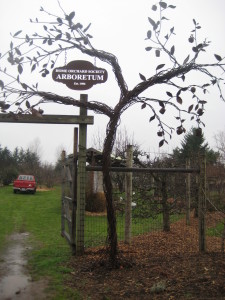
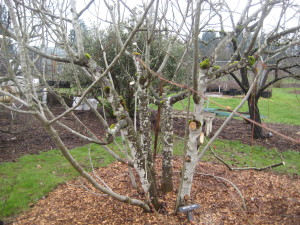
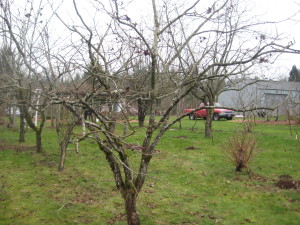
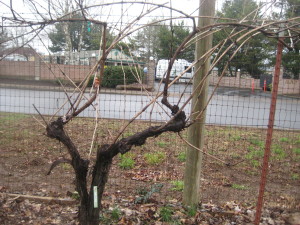
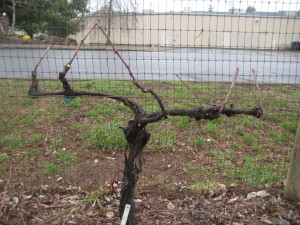
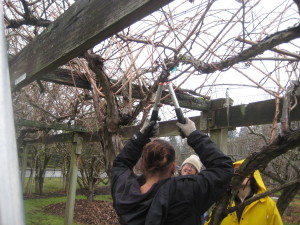
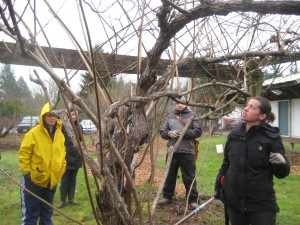
Thank you for sharing your pruning experience, Karen.
It’s amazing how much knowledge is required to prune your trees correctly. Last winter, we had severe ice storm. Thick ice on the trees lasted about a month. Our area lost so many trees. A lot of the trees like junipers were impossible to save because the whole tree bends and just snaps in half.
It was heartbreaking to see all of my neighbor’s cherry orchard dying. We lost one apple tree. I noticed that heavy old branches growing at a sharp angle to the trunk tend to split the trunk lengthwise when they break off. May be that’s another reason old branches must be pruned?
I’ve got a lot to learn this year about pruning and grafting.
Great post! I’ll be waiting for the pair tree pruning 🙂
Kimberly
My mom and I were just talking the other day about when I was in grade school/ high school we would have really bad ice storms. They are beautiful but the effects can be deadly.
We just don’t get them anymore. It might be going on 30 years since we have had one.
That could be about the old branches. I know she talked about cutting while supporting the larger branches so you don’t get that peeling away.
I’ll post after each class and let you know what I learn.
Take care,
Karen
Great info. It breaks my heart that we have had trees, especially chestnut, that were wrongly pruned, and last year didn’t produce any nuts. The year before they were abundant. Don’t know if we blew it, but we didn’t take the time to learn. I commend you for doing it the right way. Love you all …
It is sad. The previous owner pointed out a couple trees that he said NEVER produced fruit. They are Gravenstein apples and apparently they can’t pollinate anything and need other apples trees around to produce any fruit.
I still think that a lot of our low production is not correct pruning. It will probably take 3- 5 years to get everything in shape. Vines you can cut back 80% each year. Fruit trees you really shouldn’t cut back more than 30%.
I will ask Tonia if she has any information she can send me about chestnut trees. Prior to class she sends us stuff to read. I’ll see what I can get. I’ll also ask her if some trees just have heavy years followed by lean years.
Love to you and Mr. Stebbing,
Karen
I admire your adventuresome atttitute. Keep learning!
We are grateful that this class is doable for us.
With all the trees your mom had at her home she was probably pretty good at this.
Take care,
Karen
Very interesting post. That is so fantastic that you have such invaluable resources locally available for what you want to do! Really saves time on the trial & error learning.
Yes, I was happy to find them. I’ll post soon about Sunday’s class. Pear trees. We learned a lot and would just like to get started on it but that job that pays my husband always gets in the way.
Karen